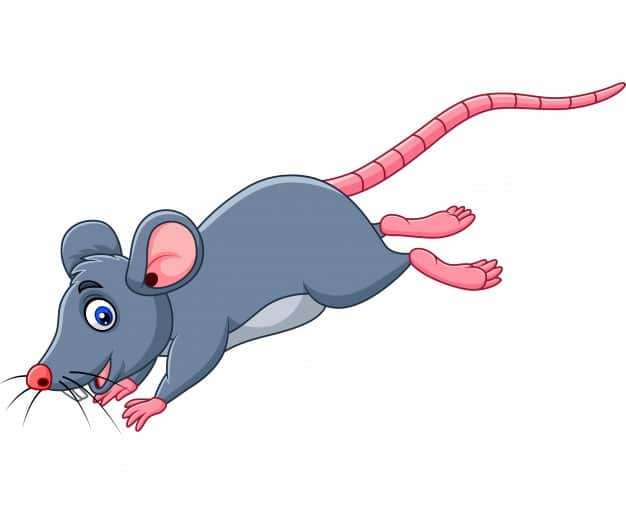Rats have tails, that’s something that almost everyone knows. Most people who do not own rats and never interact with them have misconceptions about their tails. They’re often perceived as cold, slimy, and gross appendages. However, any rat owner can tell you that this is not the case. They actually feel much like your own skin and are a vital part of their anatomy.
Nevertheless, even among people who are familiar with rats, there are many questions surrounding these hairless appendages. For instance, do you know what their tail is used for, whether it can fall off, or why there is no fur on them?
All these questions, and more, will be answered in this post by taking a look at 15 fascinating facts about rat tails. Let’s get into it!

15 Facts about Rat tails
1. Rats use their tails for temperature control
The first reason why rats have tails is for temperature control. Their tail makes up only 5% of the surface area of their body but can dissipate around 17% of their body heat. This means that it is an excellent way for them to cool down when they’re too hot.
They do this by dilating and constricting the blood vessels they have in their tail. If they want to cool down, they dilate the blood vessels so blood will flow into their tail. The blood then cools down which reduces their internal temperature.
Vice versa, when a rat is feeling cold, it will constrict the blood vessels in its tail meaning less blood will flow into the appendage, thus increasing the rat’s internal body temperature.
2. Their tail helps them climb and balance
The second reason why rats have tails is that it helps them to keep their balance. Rats climb a lot, and their tail helps them with that.
The way it helps them keep their balance is that it allows them to keep their center of gravity at the proper spot. For instance, if a rat is climbing on a rope it should keep its center of gravity right above the rope.
If he does not, he will not be able to climb it successfully because the rat and the rope will reach the moment of inertia, meaning that the rope will rotate and the rat will eventually fall off. Without a tail, they would be unable to maintain their balance, and thus they would be unable to climb difficult obstacles.
Rats are excellent climbers, and this is not in small part due to this important appendage!
3. It’s crucial for communication

The third reason why rats have tails is communication. However, it can be debated whether they have the tail for communication, or whether they simply use it for communication because they have it for the aforementioned reasons. After all, we sometimes use our hands for non-verbal communication but we probably don’t have hands for the purpose of communication, we simply use them for this purpose because we can.
An example of rats using their tails for communication is that rats may flick their it from side to side when they’re anxious or stressed. However, they can also wag it when they’re happy, just like dogs, which can make interpreting rat body language a bit difficult.
This video gives a perfect demonstration of a rat wagging its tail. As you can see, it looks extremely relaxed and happy.
4. Rats can live without their tail if necessary
Rats can live without their tail in captivity and in the wild. In captivity, they will survive just fine without it but in the wild, they will be at a severe disadvantage.
I’ve already mentioned that rats need their tails for 3 important purposes: temperature control, balance, and communication.
If they lose their tail in an encounter with a predator it means that they’re less effective at climbing and temperature control which makes their life significantly harder because it will be more difficult for them to get away from predators and to maintain proper body temperature.
In captivity, this is less of a problem and there is even a tailless rat type, but it’s definitely not ideal for them.
5. Their tails are not particularly sensitive
Rats do have feelings in their tails. However, it’s not the most sensitive part of their body because it is quite scaly. It’s kind of comparable to how you can feel when someone touches your fingernail – it’s not sensitive, but you definitely notice it when someone is touching it.
6. You should never hold your rat by its tail
Holding your pet rat by the tail hurts it and is not something you should do. While the tail itself is not very sensitive holding the animal that way puts a lot of pressure on the point where the appendage connects to the rest of the body. This is painful for your rat and causes them a lot of stress.
Also, holding your rat that way can damage the appendage itself. It can result in degloving, which is a loss of skin and deep tissue. This is incredibly painful and should be avoided at all costs.
7. Rat tails feel similar to your skin
When you see the tail of a rat it might look cold, slimy, and pretty gross. However, any rat owner can attest to the fact that this is not the case!
They actually feel much like our own skin – not slimy or gross at all. Also, since they use it to regulate their temperature it is not cold to the touch but usually quite warm.
8. Most rats cannot shed their tail
There are quite a few lizards, such as the iguana, that are capable of shedding their tail in dangerous situations. You might wonder if rats can do the same.
There are some species of rats, such as the spiny rat and the dassie rat, that can shed the skin from their tail. They do not release the entire appendage, but only the skin.
They do this in order to facilitate an escape in dire situations. However, most rats, including your pet rat (Rattus Norvegicus) are not part of the species of rats that can shed their tail.
9. Rat tails cannot grow back
Lizards that shed their tail do so because they can grow them back. Unfortunately, adult mammals, including rats, can not do the same. They can not grow back lost limbs. Once their tail is gone, it’s gone forever and it will never grow back.
10. They have bones!
Some people are under the impression that since rats can move their tails so freely it means that they do not contain bones. This is definitely not the case and rats do certainly have bones in their tails.
11. Their tails are hairless for a good reason

Rats have fur all over their body, but not on their tail. Why is that? The reason why they do not have hair on this particular body part comes back to one of the reasons why they have a tail in the first place: regulating their body temperature.
As I’ve mentioned, they use this useful appendage to regulate their body temperature by flushing it with blood which lowers their internal temperature. To do this effectively, they need it to be naked so that it can cool off faster. If it was covered in fur it would greatly diminish the efficacy as a thermoregulator.
12. Bored or stressed rats might chew on their tail
A healthy and happy rat will not eat its own tail. However, there have been reports of rats gnawing and chewing on it.
The most common reason why they do this is boredom. If your rat does not have a stimulating environment with toys and cagemates they will become bored and depressed.
This may manifest itself in them becoming destructive and destroying their surroundings. In extreme cases, it might even result in them chewing on their own tail.
If you notice that your rat is chewing or biting on itself I highly recommend that you contact a veterinarian because that’s not normal behavior.
Also read: Rat nutrition 101: what rats can and can’t eat.
13. They are scaly
Rats have scales on their tail for protection. It is an important appendage and protecting it is quite important because without it they have a much lower chance of surviving in the wild.
14. Their tails are partially prehensile
Prehensile tails are those that can be used to grab or hold objects. Many new world monkeys have this, but rats do not have fully prehensile tails since they cannot use them to grab and hold objects.
However, Wikipedia does classify rats as animals that have partially prehensile tails because they can wrap them around objects after running around them. Also, they can use them to hang from objects (albeit for a very short time).
15. You might need to clean their tail occasionally
Rats are pretty clean pets but their tail is one part of their body that can sometimes get a little dirty. You can tell when it is dirty and needs to be cleaned by taking a look at the color: if it’s a darker color than normal it might be time to give it a wash.
Cleaning your rat’s tail is quite easy. Just use a solution of some soap and water, dip a piece of cloth in it and wipe down the appendage.
If it is very dirty you can also dip their tail in a lukewarm solution of water and soap.
If you’re going to clean your rat’s tail make sure to be cautious. You do not accidentally want to hold on to their tail, spook them, and then cause them injury.
Final words
So, there you have it, everything you ever wanted to know about rat tails! They’re truly a remarkable appendage that’s more important than many people give them credit for.
They’re essential for thermoregulation, communication, and balance.
Their tails might look weird at first, but that’s simply because they look different than what most people are used to. It’s part of who rats are and in time, most people do learn to love even this part of their pet rats!
- How Long Do American Eskimo Dogs Live? Important Factors and Care Tips - September 29, 2023
- Do American Bulldogs Need Grooming? Essential Tips and Care Guidelines - September 29, 2023
- Do Bengal Cats Enjoy Playing? Essential Tips for Keeping Them Active - September 29, 2023